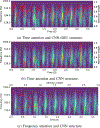Hierarchical Attentive Network for Gestational Age Estimation in Low-Resource Settings
- PMID: 37027652
- PMCID: PMC10482160
- DOI: 10.1109/JBHI.2023.3246931
Hierarchical Attentive Network for Gestational Age Estimation in Low-Resource Settings
Abstract
Assessing fetal development is essential to the provision of healthcare for both mothers and fetuses. In low- and middle-income countries, conditions that increase the risk of fetal growth restriction (FGR) are often more prevalent. In these regions, barriers to accessing healthcare and social services exacerbate fetal maternal health problems. One of these barriers is the lack of affordable diagnostic technologies. To address this issue, this work introduces an end-to-end algorithm applied to a low-cost, hand-held Doppler ultrasound device for estimating gestational age (GA), and by inference, FGR. The Doppler ultrasound signals used in this study were collected from 226 pregnancies (45 low birth weight at delivery) between 5 and 9 months GA by lay midwives in highland Guatemala. We designed a hierarchical deep sequence learning model with an attention mechanism to learn the normative dynamics of fetal cardiac activity in different stages of development. This resulted in a state-of-the-art GA estimation performance, with an average error of 0.79 months. This is close to the theoretical minimum for the given quantization level of one month. The model was then tested on Doppler recordings of the fetuses with low birth weight and the estimated GA was shown to be lower than the GA calculated from last menstruation. Thus, this could be interpreted as a potential sign of developmental retardation (or FGR) associated with low birth weight, and referral and intervention may be necessary.
Figures










Similar articles
-
Fetal growth restriction and intra-uterine growth restriction: guidelines for clinical practice from the French College of Gynaecologists and Obstetricians.Eur J Obstet Gynecol Reprod Biol. 2015 Oct;193:10-8. doi: 10.1016/j.ejogrb.2015.06.021. Epub 2015 Jul 2. Eur J Obstet Gynecol Reprod Biol. 2015. PMID: 26207980
-
Deep learning-based segmentation of whole-body fetal MRI and fetal weight estimation: assessing performance, repeatability, and reproducibility.Eur Radiol. 2024 Mar;34(3):2072-2083. doi: 10.1007/s00330-023-10038-y. Epub 2023 Sep 2. Eur Radiol. 2024. PMID: 37658890
-
Accuracy of Ultrasound to Predict Neonatal Birth Weight Among Fetuses With Gastroschisis: Impact on Timing of Delivery.J Ultrasound Med. 2021 Jul;40(7):1383-1389. doi: 10.1002/jum.15519. Epub 2020 Oct 1. J Ultrasound Med. 2021. PMID: 33002208
-
Fetal growth velocity and body proportion in the assessment of growth.Am J Obstet Gynecol. 2018 Feb;218(2S):S700-S711.e1. doi: 10.1016/j.ajog.2017.12.014. Am J Obstet Gynecol. 2018. PMID: 29422209 Review.
-
An integrated approach to fetal growth restriction.Best Pract Res Clin Obstet Gynaecol. 2017 Jan;38:48-58. doi: 10.1016/j.bpobgyn.2016.10.006. Epub 2016 Oct 20. Best Pract Res Clin Obstet Gynaecol. 2017. PMID: 27940123 Review.
Cited by
-
Mobil Monitoring Doppler Ultrasound (MoMDUS) study: protocol for a prospective, observational study investigating the use of artificial intelligence and low-cost Doppler ultrasound for the automated quantification of hypertension, pre-eclampsia and fetal growth restriction in rural Guatemala.BMJ Open. 2024 Sep 10;14(9):e090503. doi: 10.1136/bmjopen-2024-090503. BMJ Open. 2024. PMID: 39260859 Free PMC article.
-
An efficient interpretable framework for unsupervised low, very low and extreme birth weight detection.PLoS One. 2025 Jan 30;20(1):e0317843. doi: 10.1371/journal.pone.0317843. eCollection 2025. PLoS One. 2025. PMID: 39883616 Free PMC article.
References
-
- Wardlaw TM, Low birthweight: country, regional and global estimates. UNICEF, 2004.
-
- Ananth CV, “Menstrual versus clinical estimate of gestational age dating in the united states: temporal trends and variability in indices of perinatal outcomes,” Paediatric and Perinatal Epidemiology, vol. 21, pp. 22–30, 2007. - PubMed
-
- Lawn JE, Lee AC, Kinney M, Sibley L, Carlo WA, Paul VK, Pattinson R, and Darmstadt GL, “Two million intrapartum-related stillbirths and neonatal deaths: where, why, and what can be done?” International Journal of Gynecology & Obstetrics, vol. 107, pp. S5–S19, 2009. - PubMed
Publication types
MeSH terms
Grants and funding
LinkOut - more resources
Full Text Sources
Miscellaneous

